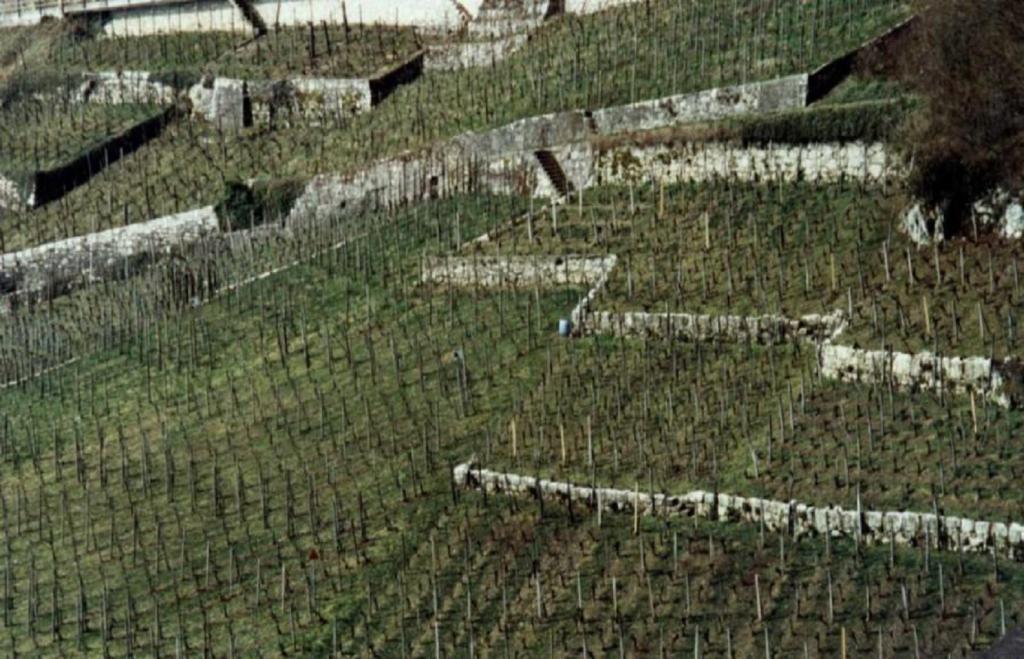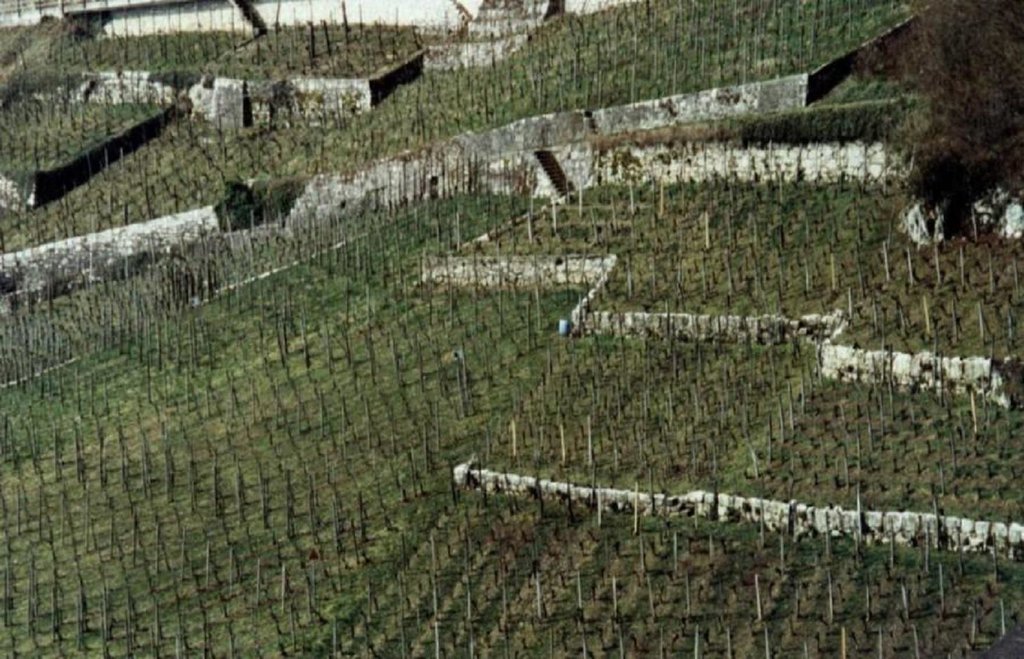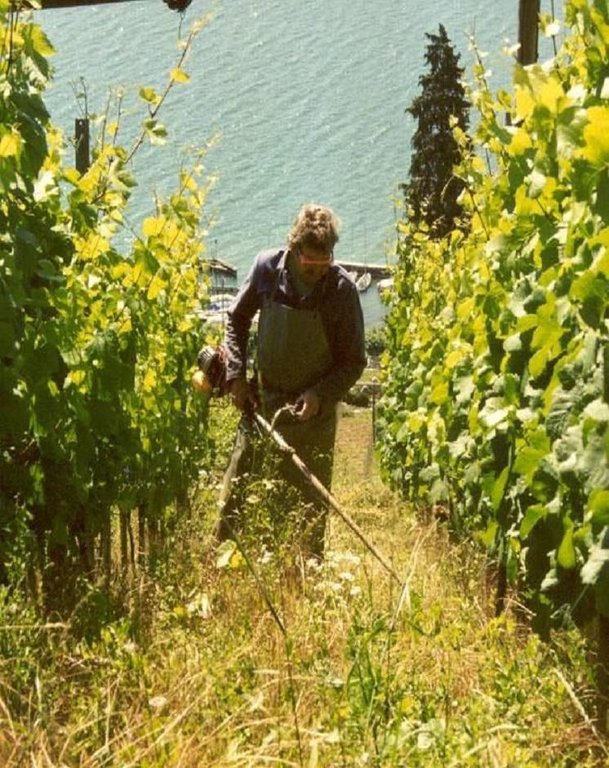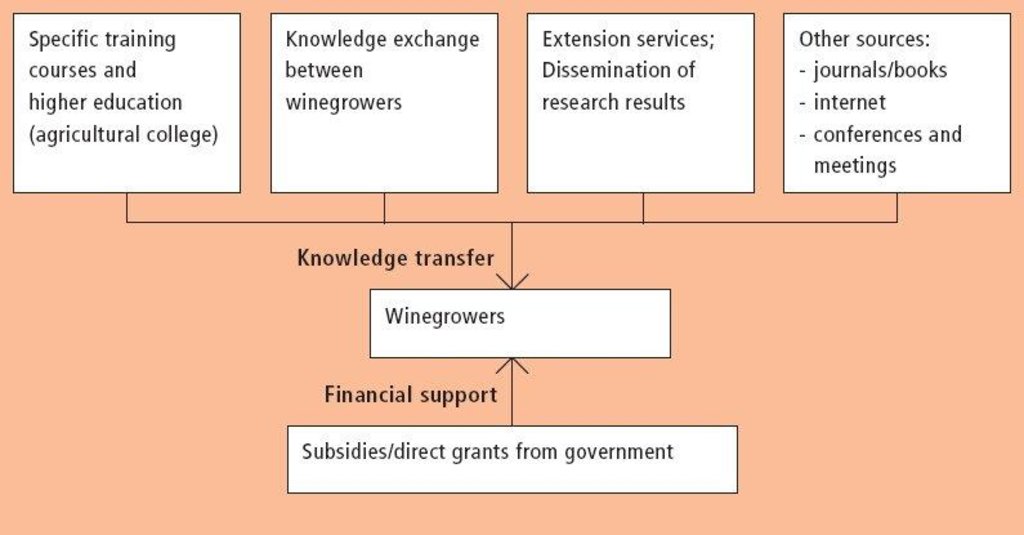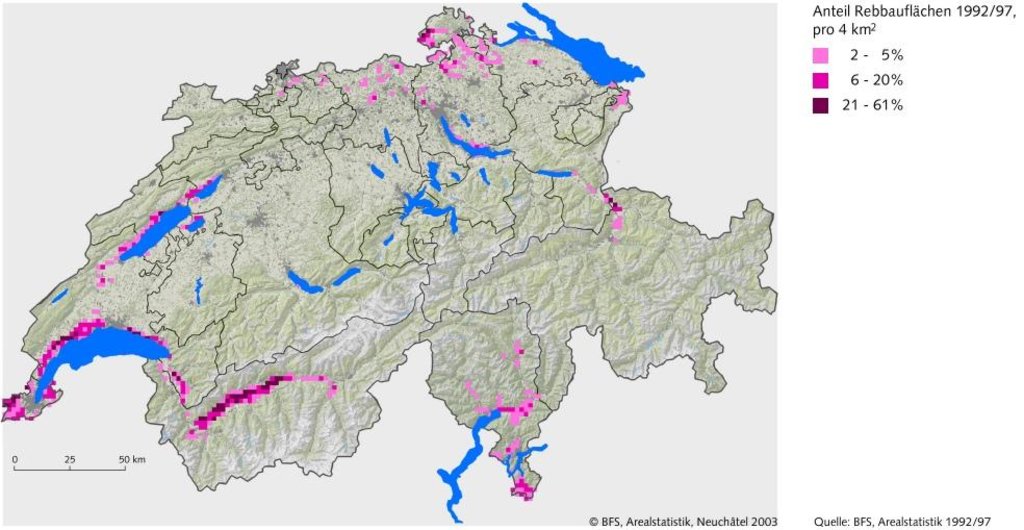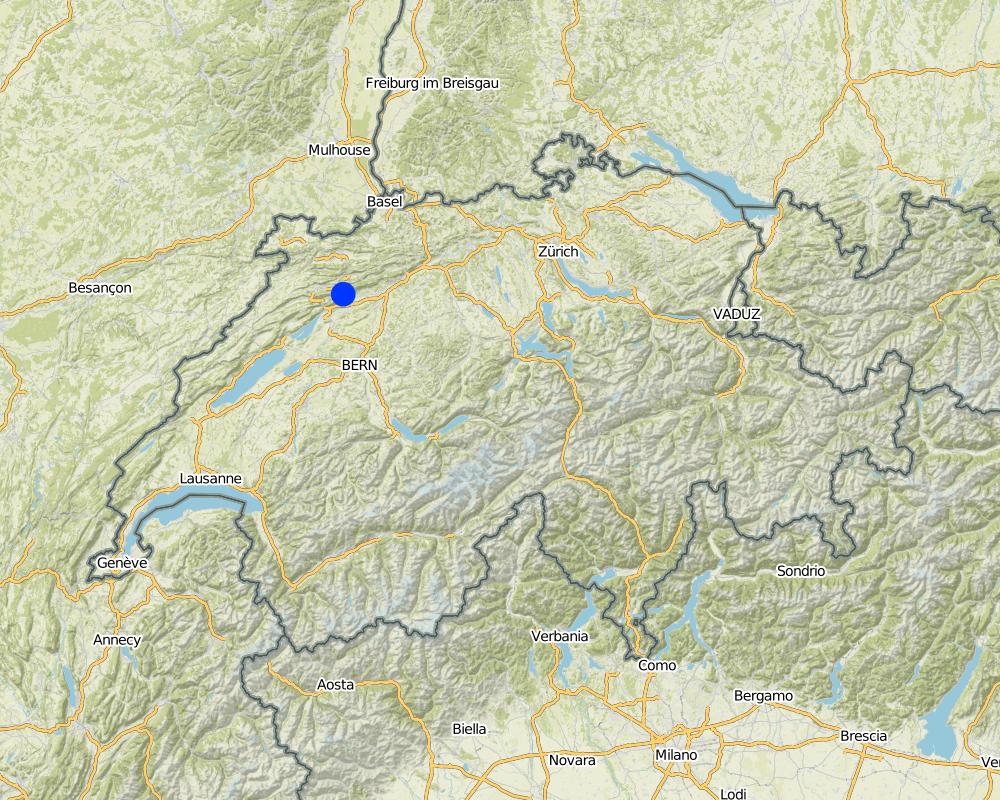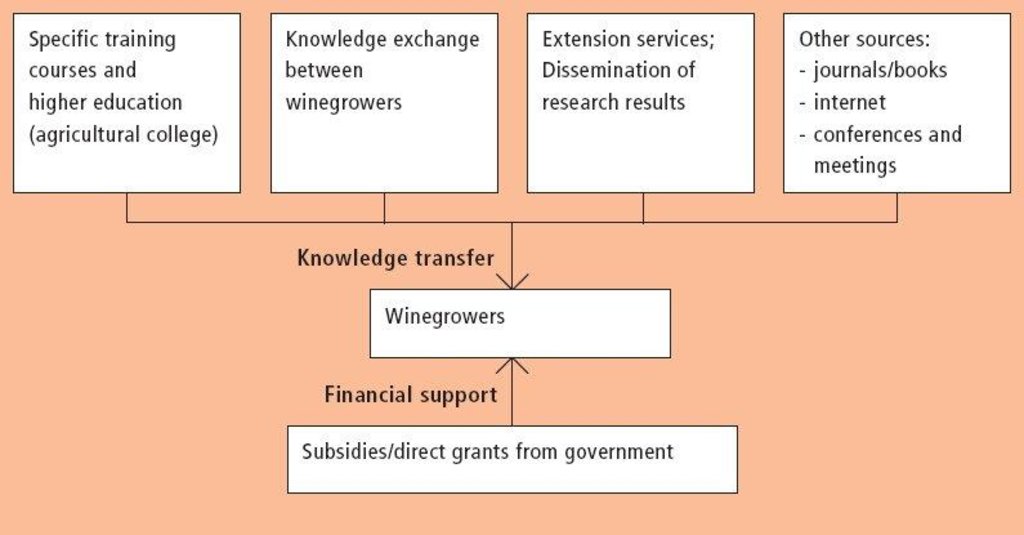Farmer initiative within enabling environment [瑞士]
- 创建:
- 更新:
- 编制者: Nicole Guedel
- 编辑者: –
- 审查者: David Streiff, Deborah Niggli
approaches_2623 - 瑞士
查看章节
全部展开 全部收起1. 一般信息
1.2 参与方法评估和文件编制的资源人员和机构的联系方式
有助于对方法进行记录/评估的项目名称(如相关)
Book project: where the land is greener - Case Studies and Analysis of Soil and Water Conservation Initiatives Worldwide (where the land is greener)有助于对方法进行记录/评估的机构名称(如相关)
CDE Centre for Development and Environment (CDE Centre for Development and Environment) - 瑞士1.3 关于使用通过WOCAT记录的数据的条件
编制者和关键资源人员接受有关使用通过WOCAT记录数据的条件。:
是
1.4 SLM技术问卷的参考
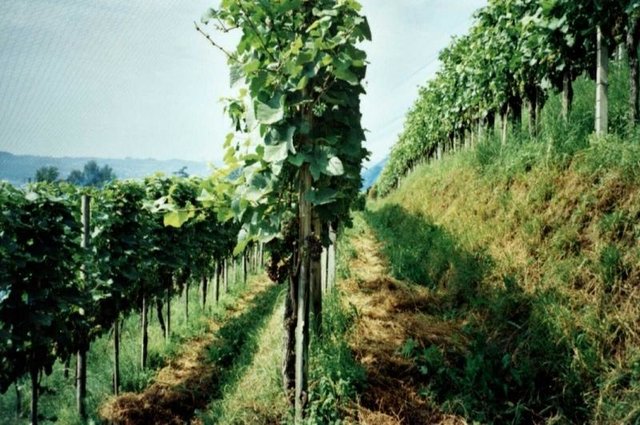
Contour small bench terraces with permanent green cover … [瑞士]
Contour small bench terraces with stabilising permanent green cover in steep sloping vineyards.
- 编制者: Nicole Guedel
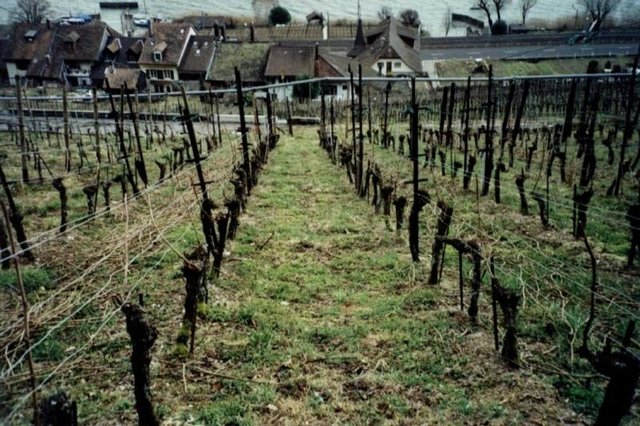
Green cover in vineyards [瑞士]
Naturally growing or sown perennial grasses/herbs providing cover between rows in sloping vineyards, where the vines are usually oriented up and down slope.
- 编制者: Nicole Guedel
2. SLM方法的描述
2.1 该方法的简要说明
Initiative and innovation of land users, stimulated by government's technical and financial support.
2.2 该方法的详细说明
该方法的详细说明:
Aims / objectives: The application of green cover (a ???living mulch??? between vine rows) in viniculture within the case study area has been developed and spread, primarily, by experimentation and exchange of knowledge between winegrowers. Individual initiatives and personal contacts have been the most important elements. Other channels are: (1) higher education and specific training courses (the majority of winegrowers have undergone at least 3 years of agricultural college, including both applied and theoretical training); (2) participation in conferences and meetings; (3) self-teaching using the internet and national and international journals or books; and (4) extension services. Disseminated results from national research institutions also play an important role - over and above individual knowledge and experimentation. The approach is thus characterised by responsiveness of winegrowers to the various information sources listed above. This should be seen in the context of national agricultural policy which provides an ???enabling environment??? including payments to farmers: the production quotas of the 1950s were replaced in 2001 by direct grants (subsidies) based on area grown and/or other specific criteria, eg ecological services such as green cover. However, the technology of green cover spread spontaneously before direct incentives were tied to ???ecological production???. Government policy supports agriculture as a weak sector of the national economy, and guarantees, through subsidies, a high percentage of the overall national production. Subsidies in Swiss agriculture are amongst the highest in the world. These subsidies effectively keep wine production going. Vineyards are seen as an important part of the rural cultural heritage and as a characteristic feature of the landscape.
Methods: Recently, with this type of production system, there has emerged a further opportunity - to market wine under a label of controlled ecological production (???vinatura???). A step further is the label of ???organic production??? which, in addition to green cover, requires a range of other criteria to be strictly fulfilled (eg no use of chemical fertilizers/biocides). Customers are increasingly willing to pay a premium for such products. This is an example of a win-win situation: the environment is protected and simultaneously farmers are rewarded with a higher value for their output. Within the framework of subsidies to farmers and information availability, the ???approach??? to improved viniculture can therefore be viewed as an enabling environment for land users to take initiatives themselves. The diffusion of innovative technologies is also largely left to the land users.
2.3 该方法的照片
2.5 采用该方法的国家/地区/地点
国家:
瑞士
区域/州/省:
Swiss viniculture area
有关地点的进一步说明:
Switzerland
注释:
The approach is not limited to the SWC technology area described in QT SWI01 and SWI02. It is rather representative for Switzerland.
Map
×2.7 方法的类型
- 传统/本土
2.8 该方法的主要目的/目标
The Approach focused mainly on other activities than SLM (viticulture as whole and its basic conditions (production of wine, financial questions, economy, technical aspects, equipment, ecology, viticulture and tourism))
The overall objective of national policy is, within a framework of subsidies, to allow farmers to develop and spread solutions themselves through access to sources of knowledge and information. The objectives of the farmers themselves are to improve their production systems through ecologically sound conservation.
The SLM Approach addressed the following problems: - initial technical problem of soil degradation within vineyards: no off the shelf solutions - slow spread of technical solutions (such as green cover which requires fundamental changes in land users attitudes)
2.9 推动或妨碍实施本办法所适用的技术的条件
社会/文化/宗教规范和价值观
- 阻碍
In a community of winegrowers who are used to either clean tillage (traditional method) or chemical weeding, green cover implies a change of values and priorities. This can cause conflicts especially between neighbours and within families
Treatment through the SLM Approach: First, rising awareness of advantages and possible disadvantages of green cover by (further) education, literature, meetings / conferences and internet by research institutions and extension services. The second step is conflict resolution on a one-to-one
了解SLM,获得技术支持
- 阻碍
The implementation of green cover is strongly dependent on factors on farm or parcel level (available infrastructure / equipment, age of vines, planting system (density and distance of vines, characteristics of supporting elements, poles, wire system...))
Treatment through the SLM Approach: Individual consultation with extension service where specific advice required
其他
- 阻碍
Natural environment: Climatic (drought, frost) and pedological (soil depth) factors can intensify water and nutrient competition to the vine, danger of frost and therefore hamper the implementation of green cover.
Treatment through the SLM Approach: Information provided by mentioned sources. Examples of possible solutions: Green cover on every second interrow; green cover only in winter; agronomic measures to temporarily eliminate competition of cover vegetation (by cutting / mulching vegetation or r
3. 相关利益相关者的参与和角色
3.1 该方法涉及的利益相关者及其职责
- 当地土地使用者/当地社区
land user themselves (their network, exchange of knowledge, implementation)
Existing groups of land users
Working land users were mainly men (because the majority of Swiss winegrowers are men)
The integration of women is a key element of the approach. Nevertheless, there are moderate differences due to cultural factors: men are mainly in charge of agricultural activities, whereas women work in the household.
- 地方政府
Districts, communities, villages
- 国家政府(规划者、决策者)
3.2 当地土地使用者/当地社区参与该方法的不同阶段
| 当地土地使用者/当地社区的参与 | 指定参与人员并描述活动 | |
|---|---|---|
| 启动/动机 | 自我动员 | |
| 计划 | 互动 | the basic idea was further enhanced by planning based on available information from various sources |
| 实施 | 自我动员 | responsibility for major steps; Responsibility of winegrowers of all steps |
| 监测/评估 | 自我动员 | Mainly: measurements/observations; partly: workshop/seminars, public meetings, reporting; Observation by land user. Some indicators are evaluated by extension services or research institutions. |
| Research | 互动 | on-station; Both on-farm and on-station |
3.3 流程图(如可用)
3.4 有关SLM技术选择的决策
具体说明谁有权决定选择要实施的技术:
- 仅限土地使用者(自主)
解释:
Decisions on the method of implementing the SLM Technology were made by by land users* alone (self-initiative / bottom-up)
4. 技术支持、能力建设和知识管理
4.1 能力建设/培训
是否为土地使用者/其他利益相关者提供培训?:
是
培训形式:
- 在职
- 农民对农民
- 示范区域
- 公开会议
- 课程
涵盖的主题:
There are various possibilities which include green cover as one of several topics: (1) agricultural college (three years, including both practical and theoretical knowledge); (2) further education (full time or short courses) at agricultural universities; (3) attendance at regional, national or international meetings/conferences, organised by research institutions, extension services, or
4.2 咨询服务
土地使用者有权使用咨询服务吗?:
是
指明是否提供了咨询服务:
- 在土地使用者的土地上
说明/注释:
Adoption; Key elements: palette of information sources, informal contacts, discussions, observations of different systems under personal trials.1) Advisory service was carried out through: non-governmental agency, government's existing extension system 2) Advisory service was carried out through: non-governmental agency, government's existing extension system; Extension staff: mainly government employees
Advisory service is very adequate to ensure the continuation of land conservation activities
4.3 机构强化(组织发展)
是否通过这种方法建立或加强了机构?:
- 否
4.4 监测和评估
监测和评估是该方法的一部分吗?:
是
注释:
bio-physical aspects were ad hoc monitored by land users, other through observations; indicators: rate of erosion, organic matter content, soil moisture, water potential in vine leaves, compaction, soil structure, soil temperature, biodiversity, chemical analysis of wine, nutrient elements in soil and vines
technical aspects were ad hoc monitored by land users, other through observations; indicators: change of attitude towards green cover, knowledge about SWC and awareness of natural environment, change of appearance of man-made landscape
socio-cultural aspects were ad hoc monitored by land users, other through observations; indicators: costs, production, quality, manual labour, machine hours etc. Often data are not specifically gathered for green cover but total establishment and annual recurrent costs for different winegrowing systems can give some insight into the economic status of green cover
economic / production aspects were ad hoc monitored by land users through observations; indicators: diffusion of green cover (visual impression of the current status, time-series photos, descriptions from past)
area treated aspects were ad hoc monitored by 0 through observations; indicators: number of households involved (with a questionnaire, personal estimation, visual impressions), Number of farmers receiving direct payments
no. of land users involved aspects were ad hoc monitored by other through observations; indicators: None
There were few changes in the Approach as a result of monitoring and evaluation: Few changes to the technology or the approach have resulted directly from formal monitoring and evaluation.
4.5 研究
研究是该方法的一部分吗?
是
提供进一步的细节,并指出是谁做的研究:
Especially ecological and technical aspects are important elements of the research institutions concerning SWC: e.g. management of green cover such as dealing with competition of water and nutrients to the vine or promoting living space for animals (especially insects) beneficial to grape production (e.g. promoting predators of pests as a possibility of biological pest control). But also economic
Research was carried out both on station and on-farm
5. 融资和外部物质支持
5.1 该方法中SLM组成部分的年度预算
注释(例如主要的资助来源/主要捐助者):
Approach costs were met by the following donors: government (national): 70.0%; local community / land user(s) (-): 30.0%
5.2 为土地使用者提供财政/物质支援
土地使用者是否获得实施该技术的财政/物质支持?:
是
5.3 对特定投入的补贴(包括劳动力)
如果土地使用者的劳动力是一项重要的投入,那么是不是:
- 自愿
注释:
Labour is a substantial input and exclusively done voluntary by land users - though the overall agricultural system is subsidised
5.4 信用
是否根据SLM活动的方法给予信用值?:
否
6. 影响分析和结论性陈述
6.1 方法的影响
该方法是否帮助土地使用者实施和维护SLM技术?:
- 否
- 是,很少
- 是,中等
- 是,支持力度很大
The approach (with all its elements) has led to greatly improved soil and water management.
6.3 方法活动的可持续性
土地使用者能否维持通过该方法实施的措施(无外部支持的情况下)?:
- 是
若是,请说明如何维持:
Within the framework of the existing national policies the approach is sustainable.
6.4 该方法的长处/优点
| 编制者或其他关键资源人员认为的长处/优势/机会 |
|---|
| Very bottom-up oriented. The interest, the own initiative and the generation of own experience and knowledge is the dominant motor (How to sustain/ enhance this strength: Maintain the enabling environment put in place by the government which is the framework for this approach.) |
| Many information sources and ways of receiving information are available and used frequently. |
6.5 该方法的弱点/缺点以及克服它们的方法
| 编制者或其他关键资源人员认为的弱点/缺点/风险 | 如何克服它们? |
|---|---|
| Winegrowing as a whole is highly dependent on financial incentives. Without direct payments, continuation of Swiss winegrowing and therefore green cover would be threatened ??¡§ at least under marginal conditions | Continue the incentive policy (though this may conflict with international efforts to reduce farm subsidies worldwide). |
7. 参考和链接
7.1 方法/信息来源
- 实地考察、实地调查
- 与土地使用者的访谈
7.2 参考可用出版物
标题、作者、年份、ISBN:
Guedel N (2003) Boden- und Wasserkonservierung in Schweizer Rebbergen. Ein Beispiel im Rahmen von WOCAT. Unpublished
可以从哪里获得?成本如何?
Centre for Development and Environment, University of Berne
链接和模块
全部展开 全部收起链接

Contour small bench terraces with permanent green cover … [瑞士]
Contour small bench terraces with stabilising permanent green cover in steep sloping vineyards.
- 编制者: Nicole Guedel

Green cover in vineyards [瑞士]
Naturally growing or sown perennial grasses/herbs providing cover between rows in sloping vineyards, where the vines are usually oriented up and down slope.
- 编制者: Nicole Guedel
模块
无模块


